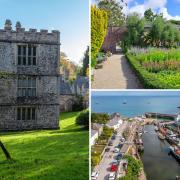Ceramcist Joanna Wason on talks about her work at Cornwall's famous Leach Pottery in St Ives

Ahead of her solo exhibition at the Leach Pottery, MERCEDES SMITH meets Joanna Wason, whose work reflects a world of creative influence and a decade as assistant to Janet Leach.
Joanna Wason is central to one of the most important stories in contemporary ceramics, though when I put it to her like that she laughs with incredulity and real modesty.
The facts are though that Joanna was studio assistant and good friend to celebrated 20th Century potter Janet Leach. As such she holds in her memory not just a fascinating personal history of her friendship with Janet, but also of the Leach Pottery’s turbulent transition into the 21st century. Hers is an oral history begging to be committed to memory stick, but until then her first solo exhibition at the Leach Pottery gives great insight into the life and influences of one of Cornwall’s most significant but rarely exhibited potters.
Joanna grew up near Bideford in Devon and was influenced at a young age by the town’s 400 year history of slipware production. She studied at Exeter College of Art and Liverpool Art School and later married Jason Wason, now a highly respected potter himself. The couple moved to West Cornwall in 1976 when Jason took up a position at the Leach Pottery, but it was another 12 years before Jo would work there. Jo was busy raising a family, doing part time work and making ceramic sculptures when she was invited to become Janet’s studio assistant in 1988. She had already exhibited at Newlyn Art Gallery, the Hypatia Trust and elsewhere in Cornwall, but working with Janet gave her the opportunity to devote her working life entirely to pottery.

I worked at some rather laborious jobs at that time, mostly on local farms, also as a waitress, so I felt very lucky to find myself here in this interesting new environment,’ she tells me. I spent my time preparing clays, mixing glazes and making saggars and really enjoyed working with Janet. She was great to talk to and was an engaging storyteller. I learned a huge amount working for her.’
Jo acted as Janet’s workshop and personal assistant until Janet’s death in 1997 and during those ten years they became good friends. Janet was such a warm-hearted person, but people who didn’t really know her didn’t always see that. She was very independent and if people didn’t like her she really didn’t care! It was a lot of responsibility for her to manage the workshop, but when she came here in 1956 she put it on a steady course financially and in terms of pottery design.’ Apart from the wealth of technical knowledge, working with Janet gave Jo access to the culture and history of international ceramics. I learned such a lot from Janet’ Jo says.
I absorbed a huge amount just from talking to her over the years. And of course I was useful to her work. I was surrounded by her pots and by Bernard’s and her wonderful collection of pots from all over the world, Chinese and Korean, work by Bernard, Hamada and Lucie Rie. Over time I definitely absorbed an aesthetic.’
When Janet died, Jo stayed on at the pottery and was one of the last staff potters at the Leach when it closed its doors in 2005. She now works from her studio near St Just making ceramic sculptures and uniquely beautiful pots, many of them in the Leach tradition. She also remains an important member of the Leach Pottery team, continuing to work part time in the Pottery’s gallery and museum, and in 2010 she curated a highly regarded retrospective of Janet’s work. When the pottery reopened in 2008 it was so changed physically, we wanted to put the history of the pottery straight back into it from the start,’ says Jo. Part of that history is Janet and her work, and so Julia asked if I would curate an exhibition of Janet’s life and work’
Jo was the obvious choice to curate the show,’ says Leach Pottery director Julia Twomlow. She knew Janet well and knows everything about her work. Because of that the show was a great success.’ Now it is Jo’s pottery that will take centre stage, as a new collection of close to 100 works goes on show in the Pottery’s Entrance Gallery. Showcasing the originality and sheer breadth of her output, the exhibition includes porcelain, stoneware and slipware pieces and figurative sculptures in iron or bronze resin.
My pottery is functional. I make bowls, tea bowls, boxes and vases. When I first arrived here I mixed the glazes from the Leach Pottery recipe book for us all, and I used these same glazes myself. I didn’t know any chemistry so I developed my own simple ash glazes from the start. And I particularly love slipware,’ Jo continues. I have an old Bideford slipware jug from the late 1700s which I have always admired. I think it was decorated by children, lots of children worked in the potteries then. Bideford slipware includes sgraffito and beautiful honey glazes, and these are techniques I’ve used myself. Now I paint layers of coloured slip over each other, benefitting from the lack of control that comes from using rough, older brushes.’
Of her distinctive figurative sculptures Jo tells me, Someone asked me years ago to make some pieces in the Mycenaean figurative style and the work developed from there. Mycenaean sculptures are amazingly minimal and really quite odd - tiny figures in huge chairs for example. I find them very amusing and I hope that people will like and laugh at my some of my sculptures in the same way. They contrast with the lush colours of my slipware and more staid stoneware and porcelain works. This is my first solo exhibition, and I am delighted to be showing here at the Leach Pottery. It has been interesting putting the work together, and to discover how little time and space I have these days to make so many pots!’
This article first appeared in Cornwall Life May 2015



























